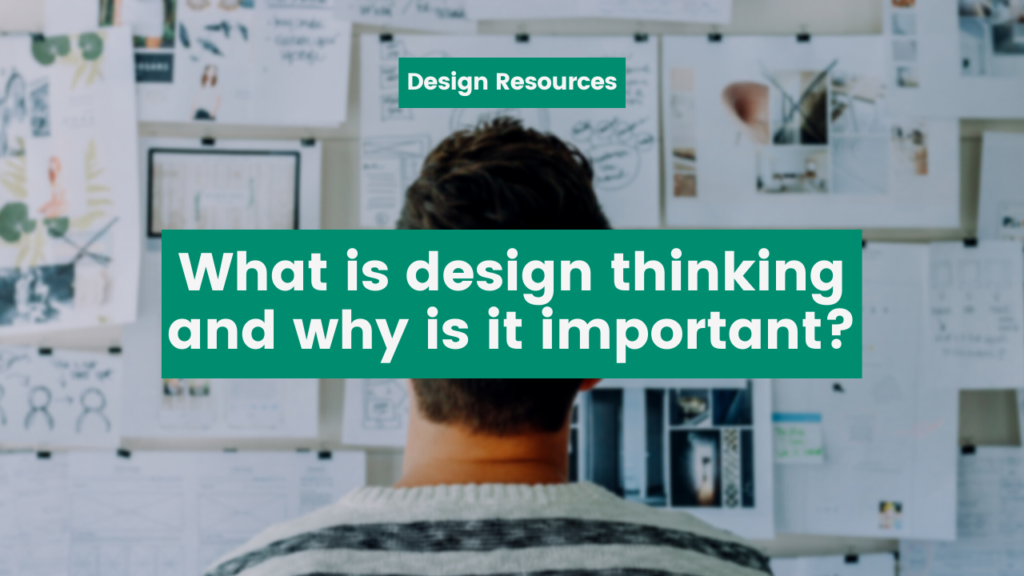If you work in a creative team, you might have asked yourself the question, “What is design thinking?” Design thinking is more than just another way to design your product. This design process is crucial for solving complex design problems with user-centric solutions.
As a creative team member or someone who creates products for the general audience, you might have encountered some user experience-related roadblocks. You might have made a fantastic product that nobody wanted. The best way to overcome this problem is through design thinking.
In this guide, we will discuss all topics related to design thinking. We will break down the process, how it is useful and how you will solve your user experience dilemma.
At the end of this guide, you will be able to answer the question – “what is design thinking?”
Cut design & video review time in half
Try GoVisually free today!
Table of Contents
What is design thinking?
If you are creating a product intended for the general audience, you must ask yourself – “what is design thinking?”
The answer to this question will help you make something that people will enjoy and readily purchase again.
Many of the world’s leading brands like Pepsi Co, Google, Apple, and Samsung use design thinking to generate their products. So let’s get to the bottom of what is design thinking process.
In the simplest terms, design thinking is a process that uses creative and practical problem-solving solutions. Mainly designers use this process, but its application is found in multiple industries such as business, architecture, and engineering.
At the core of design thinking, you seek to understand your users better. In this process, you must challenge any assumptions and develop creative solutions.
Your overall goal should be to identify alternative solutions that were not apparent in your early level of understanding. In a nutshell, design thinking is a solution-based approach to solving user experience problems.
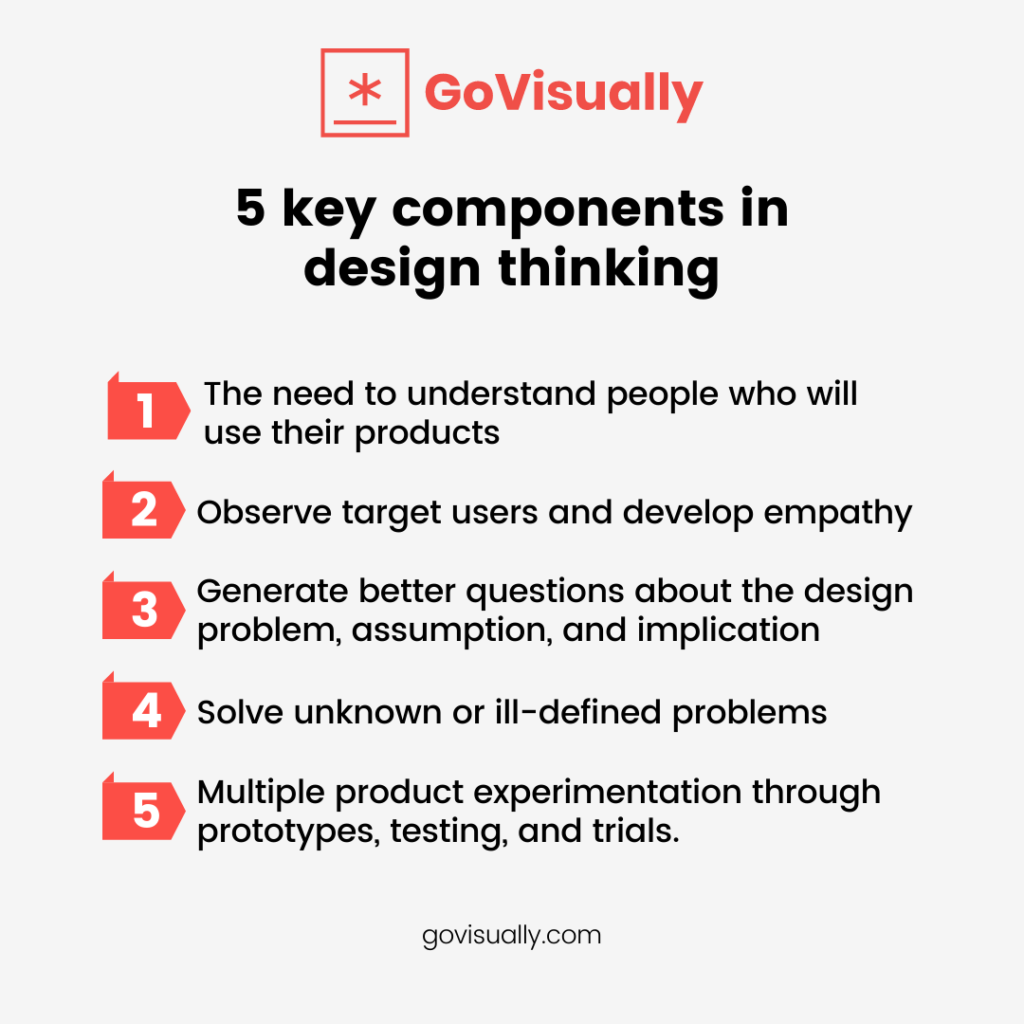
What is design thinking process vs. the user-centered design process?
Even though design thinking and user-centered design sound similar, they are very different from each other. In the early design stages, a user-centered design creates solutions based on users’ needs and feedback. The user-centered design focuses on fostering empathy with the people you are designing for.
However, design thinking is different from UC design. While design thinking considers user knowledge while creating a product, they also look at business goals and technological feasibility.
The design process doesn’t solely focus on user problems but combines user knowledge with other facets to create well-rounded products that benefit the company and the user.
The 4 principles in design thinking
Design thinking is more than coming up with creative solutions. Four important components create a thorough and effective design process. Before we start dissecting the design process, let’s look at the 4 key principles in design thinking.
These principles were put together by professors Christoph Meinel and Harry Leifer at the Hasso-Plattner Institute of Design at Stanford University, California. Since experienced design scholars put forward these principles, you should consider them to generate effective creative solutions.
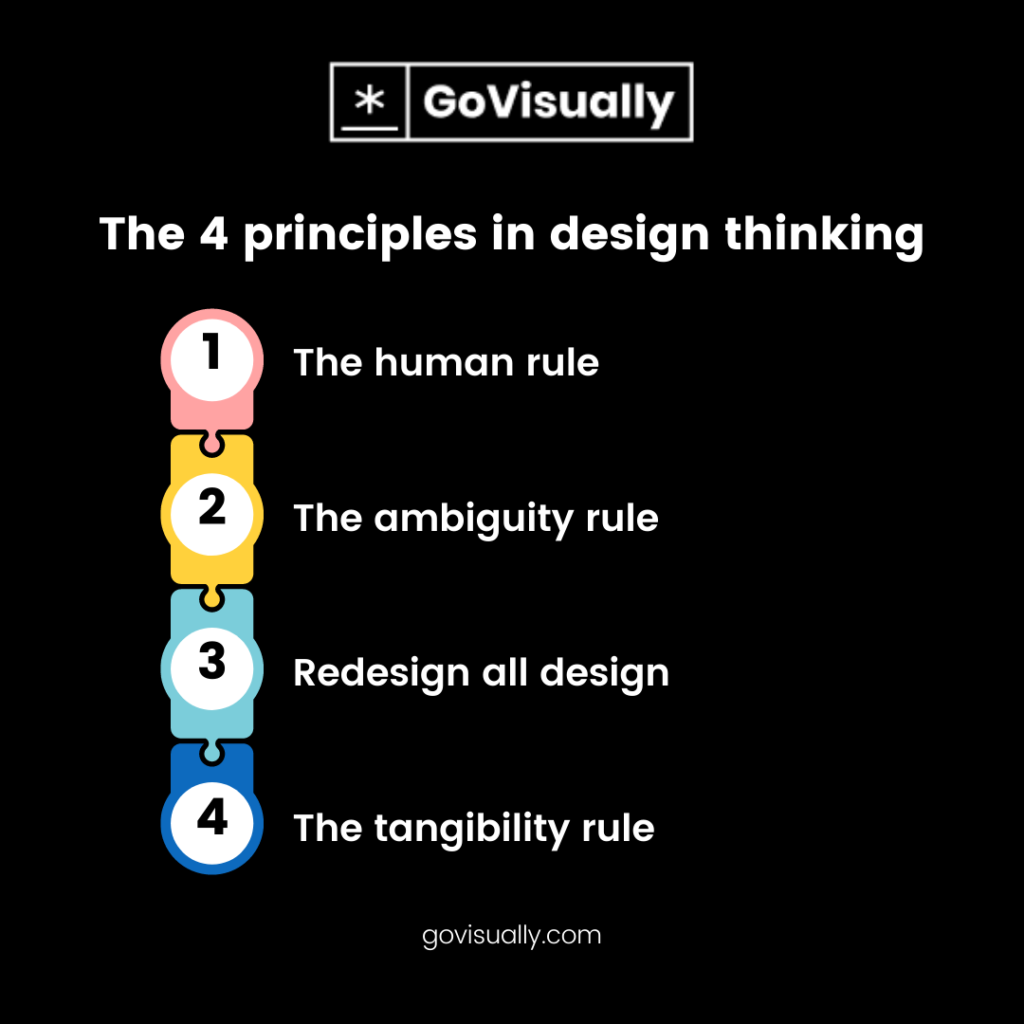
The human rule
Whatever the context, all design activity is social, and any design innovation should bring us back to a human-centered perspective. All design teams should remember this phrase before they start the design process.
The human rule states that your users should be the focal point in designing your products or service. Design teams must understand the user’s needs and how they behave and think. They should use this knowledge to create creative solutions to real problems.
The ambiguity rule
The ambiguity rule refers to the phenomenon that ambiguity is inevitable; you cannot remove or oversimplify it. This rule stresses the importance of experimenting at the limits of your knowledge to see things differently. In a nutshell, the ambiguity rule is about exploring different options to solve a problem.
If your design team lacks knowledge on a certain aspect, don’t ignore it. Try to hypothesize and test your ambiguity to create the best possible solution.
Redesign all designs
Even though technology and social circumstances change, basic human needs remain the same. Despite rapidly changing technology, basic human needs will always be the same, and therefore you should always remember them when creating your product. When we redesign, we only change the means of solving the problem.
The tangibility rule
In this rule, designers must create tangible prototypes to communicate their ideas effectively. Actual prototypes will help you realize which ideas work and which don’t. This testing stage will help you make a seamless design process.
What are the five stages of the design thinking process?
Now that you know what design thinking is let’s take a closer look at each of the stages to understand the design thinking process better.
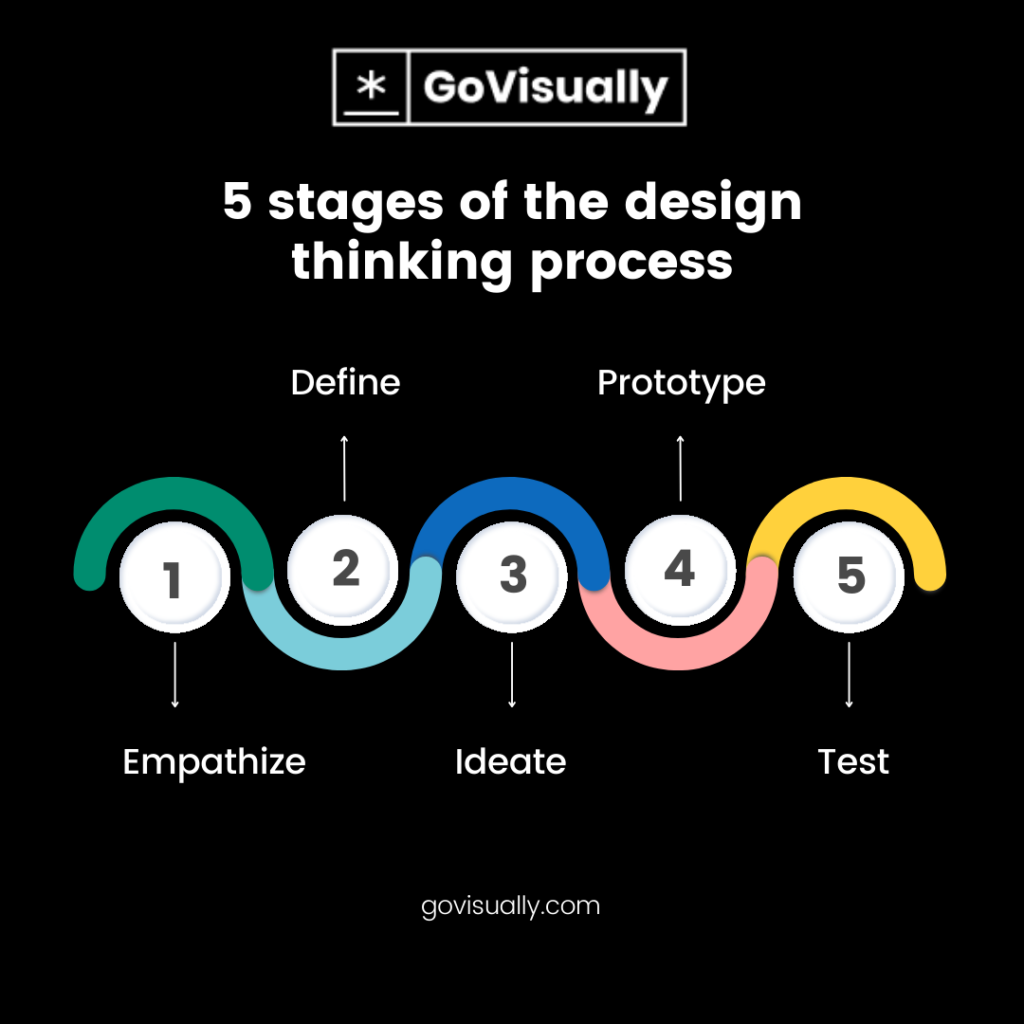
Stage 1 – empathize
Empathy is a crucial starting point in the design thinking process. You should try to gain an empathetic understanding of the design problem at this stage.
Typically, you will gain empathetic knowledge through user research. To create a user-centric product design, try to understand users’ needs, wants, objectives, and pain points.
At this stage, you should also get rid of any assumptions and preconceived ideas to empathize with users fully. You should try to gain real insight into people on a psychological and emotional level.
Stage 2 – define
In the second stage of the design process, it’s time to define your research into a problem. Analyze and synthesize your observations to come up with user pain points. Your empathetic research in stage 1 will help you create a problem that many users experience.
What barriers and difficulties do you users experience? What patterns are common challenges amongst several users? These are some questions you need to ask yourself when defining a user problem.
At the end of your define phase, you should develop a problem statement. Remember to frame your problem statement in a user-centric way. Instead of saying, “We need to solve…”, prepare the idea for your users: “Older millennials in the city….”
Once you have a clear problem statement, you can start working on stage three.
Stage 3 – ideate
With a solid understanding of your target user’s issues and a clear problem statement, you can start working on potential solutions. At this stage, you can be as creative as you want to come up with the best possible solutions.
Design teams can use multiple ideation methods such as mind mapping and brainstorming to establish alternatives. Design teams should hold ideation sessions to develop as many angles as possible to create various ideas. At the end of this process, you should have a shortlist of potential solutions you will test out in the next stage.
Stage 4 – prototype
This stage in the design process is all about experimenting and turning your ideas into tangible items. A prototype is an early iteration of your finished product, and it incorporates potential ideas from the previous stage.
At this stage, your goal is to test the prototypes and identify any flaws or limitations. You should improve, redesign and remove your potential ideas depending on how they work as prototypes.
Stage 5 – test
After you build your prototypes, you must put them to the test. In this stage, you should collect feedback from your testing process to improve your product design.
Even though this is the last stage in the design thinking process, it will often lead you to previous steps. If your test fails, you will have to redesign your product and follow the previous steps again to create a well-tested product.
Is the design thinking process linear?
Design thinking is not a linear process despite the multiple steps you will follow. This process is fluid and flexible, and you might go between two or more steps multiple times.
With each step, you might discover a new problem or solution, and so you will redesign and reconfigure multiple times. Even though design thinking is non-linear, it ensures your product will fit your target user’s needs.
Why is design thinking important?
Now that you know more about the design thinking process, you might ask, “why is design thinking important? There are several benefits of implementing design thinking for your business.
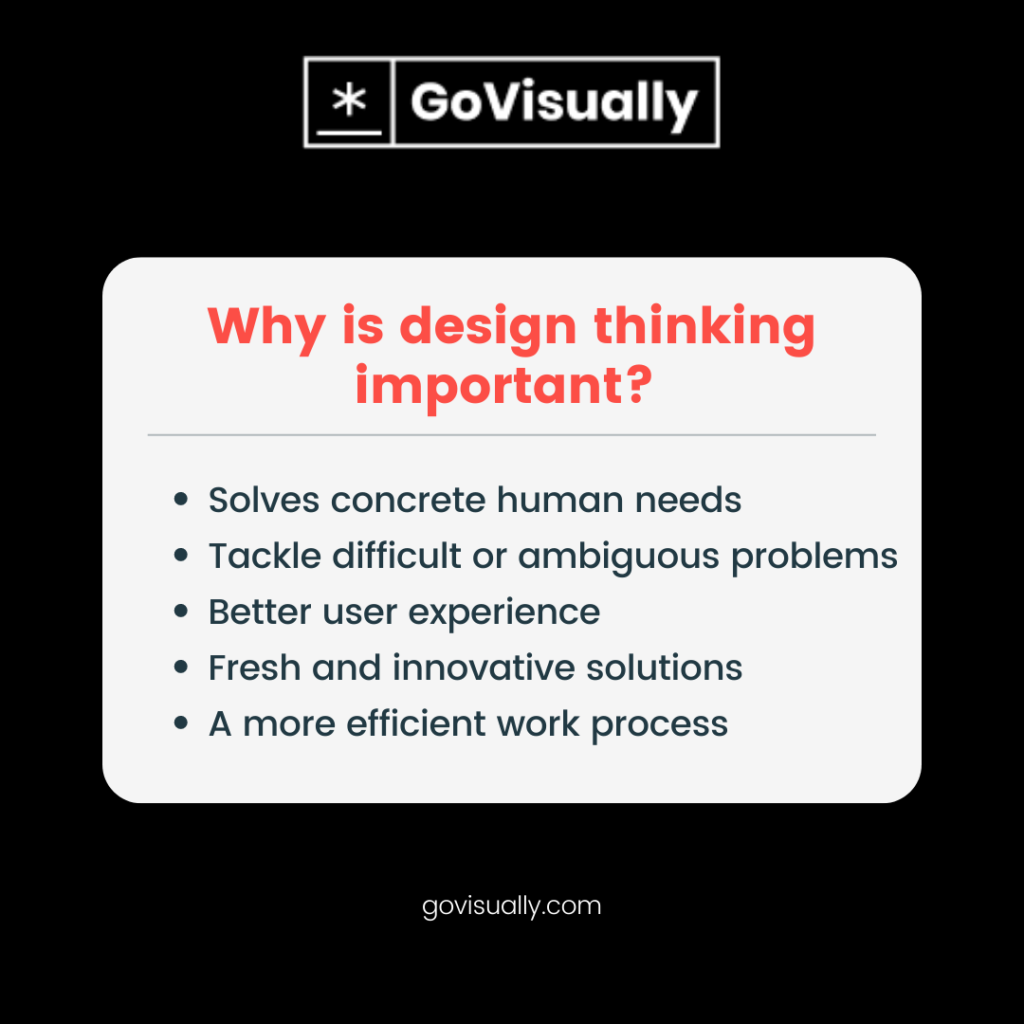
Solves concrete human needs
Design thinking provides crucial solutions to solve human needs effectively. It makes it possible for organizations to create lasting value for customers. Design teams learn about users’ pain points that they never thought of before using a well-researched and human-centered approach.
Tackle difficult or ambiguous problems
Consumers often don’t know what problems they face, or they might not know how to verbalize these issues. Design thinking aims to create products that solve ambiguous or difficult user problems.
The best method of defining these user problems is by observing their behavior. With design thinking, you observe consumer behavior, establish a pattern and design a problem to tackle this issue.
Better user experience
Every company needs to communicate effectively. The best way to listen to your customer is through design thinking. You listen to your customers’ needs and create a better user experience.
Fresh and innovative solutions
Design thinking will help you create innovative solutions to solve consumer pain points. Most people don’t think of innovative problem-solving methods; therefore, design thinking will help you cater to this human need.
A more efficient work process
Even though design thinking is not linear, it will help you organize and streamline your design process. Design teams should follow design thinking steps to logically and systematically create effective and testable products.
What are the benefits of design thinking in a workplace?
If you manage a design team or are a creative team member, you must understand the pivotal role design thinking plays in your daily work life. Implementing design thinking increases business value and helps you create desirable products for consumers.
With this in mind, let’s look at some more benefits of design thinking in the workplace.
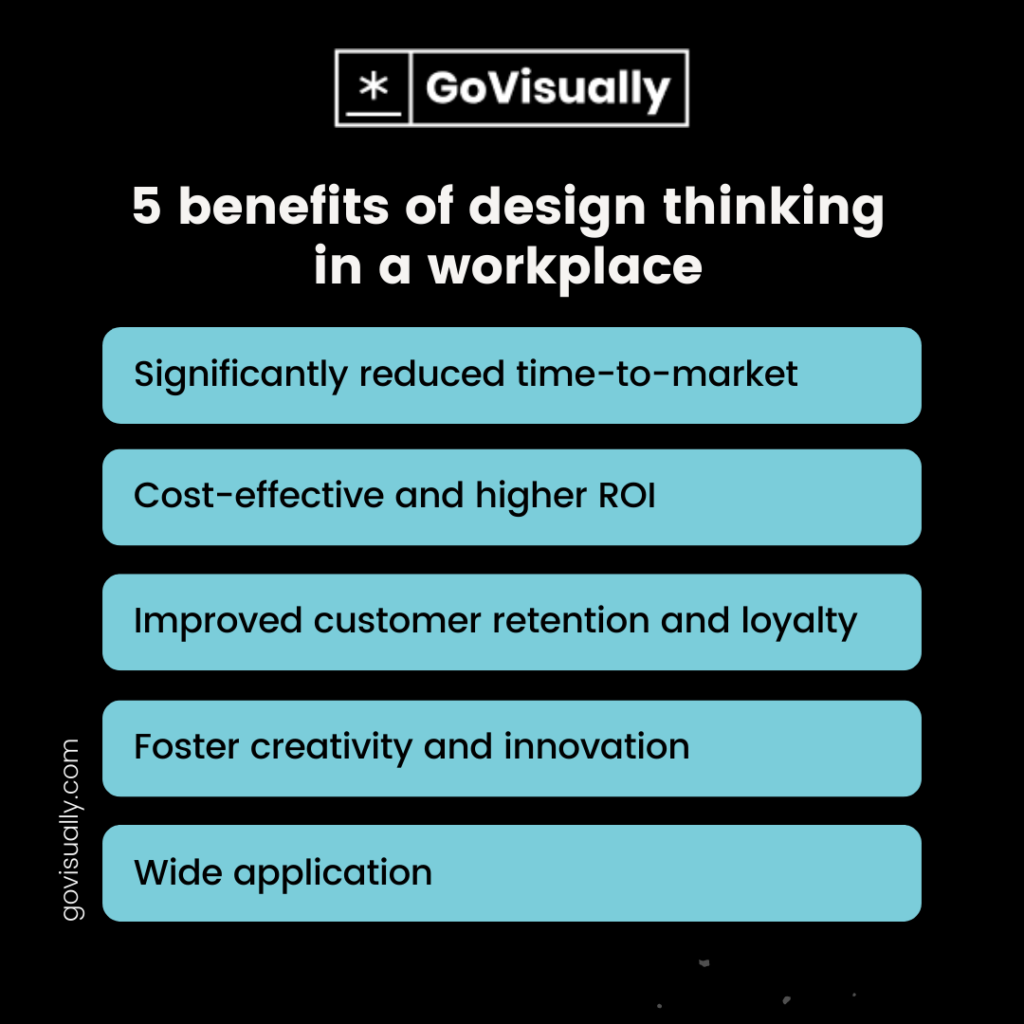
Significantly reduced time-to-market
Design thinking significantly reduces your company’s time-to-market because it focuses on problem-solving and finding potential verifiable solutions.
Cost-effective and higher ROI
Since your business gets products to the market faster, you cut down your business expenditure. Design thinking also yields significant ROI, and companies achieve one-third higher revenue and 56% higher returns.
Improved customer retention and loyalty
The user-centric approach is at the heart of design thinking. When your products are created with this perspective, customers are more likely to remain loyal to your brand. Your business will maintain customer retention in the long term because of design thinking.
Foster creativity and innovation
At the core of design think, you challenge assumptions and encourage team members to think outside the box. This innovative thinking fosters creativity that helps your brand stay ahead of the curve.
Wide application
While this article mostly focuses on design thinking for creative teams, you can apply design thinking to almost any company sector. Design thinking encourages team collaboration and group thinking to ensure everyone works along seamlessly and effectively.
Design thinking is also applicable across multiple industries. For example, if you are a chef, you can use design thinking to create a specific menu that caters user target users’ culinary needs. Nursing home companies will benefit from design thinking to make their establishment comfortable for their residents.
These are a few examples of how design thinking benefits multiple industries. There are endless applications of design thinking.
Key takeaway
Design thinking is an important tool because it streamlines your creative process and improves engagement with your customer base. It helps elevate your marketing techniques while growing your business.
We hope you find our guide helpful in understanding the importance of design thinking. If you have any questions about it, do let us know.
Want to send big files?

Need a quick way to share large files and creative assets?
With GoVisually Share, it’s absolutely free! Try today.
